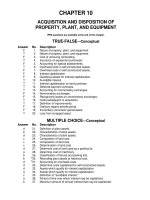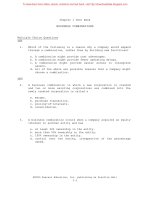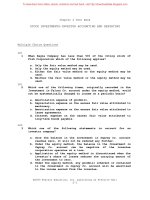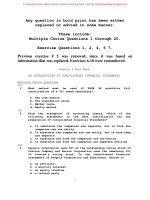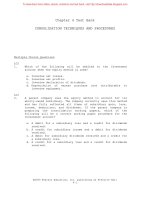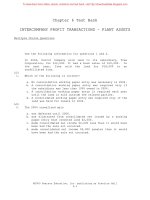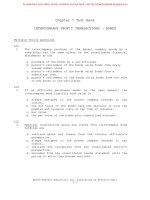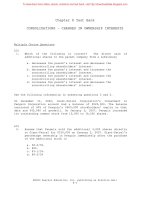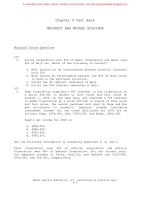Test bank cost accouting 6e by rainborn chapter 10
Bạn đang xem bản rút gọn của tài liệu. Xem và tải ngay bản đầy đủ của tài liệu tại đây (153.53 KB, 37 trang )
To download more slides, ebook, solutions and test bank, visit
Chapter 10—Relevant Information for Decision-Making
LEARNING OBJECTIVES
LO 1
LO 2
LO 3
LO 4
LO 5
LO 6
LO 7
LO 8
What factors are relevant in making decisions and why?
What factors are relevant in making decisions and why?
What are the relevant considerations in outsourcing?
How can management make the best use of a scarce resource?
How does sales mix pertain to relevant costing problems?
How are special prices set, and when are they used?
How is segment margin used to determine whether a product line should be retained or
eliminated?
(Appendix) How is a linear programming problem formulated?
QUESTION GRID
True/False
Difficulty Level
Easy
1
2
3
4
5
6
7
8
9
10
11
12
13
14
15
16
17
18
19
20
21
22
23
24
25
26
27
28
Moderate
x
x
x
x
x
Learning Objectives
Difficult
LO 1
LO 2
LO 3
LO 4
LO 5
LO 6
LO 7
LO 8
x
x
x
x
x
x
x
x
x
x
x
x
x
x
x
x
x
x
x
x
x
x
x
x
x
x
x
x
x
x
x
x
x
x
x
x
x
x
x
x
x
x
x
x
x
x
x
x
x
x
x
372
To download more slides, ebook, solutions and test bank, visit
Completion
Difficulty Level
Easy
1
x
2
x
3
x
4
x
5
x
6
x
7
x
8
x
9
x
10
11
Multiple Choice
Moderate
Learning Objectives
Difficult
LO 1
LO 2
LO 3
Easy
LO 5
LO 6
LO 7
LO 8
x
x
x
x
x
x
x
x
x
x
Difficulty Level
1
2
3
4
5
6
7
8
9
10
11
12
13
14
15
16
17
18
19
20
21
22
23
24
25
26
27
28
29
30
31
32
33
LO 4
x
x
x
Moderate
Learning Objectives
Difficult
x
x
x
x
x
x
x
x
x
x
x
x
x
x
x
x
x
x
x
x
x
x
x
LO 1
LO 2
LO 3
LO 4
LO 5
LO 6
LO 7
x
x
x
x
x
x
x
x
x
x
x
x
x
x
x
x
x
x
x
x
x
x
x
x
x
x
x
x
x
x
x
x
x
x
x
x
x
x
x
x
x
x
x
373
LO 8
To download more slides, ebook, solutions and test bank, visit
Difficulty Level
Easy
34
35
36
37
38
39
40
41
42
43
44
45
46
47
48
49
50
51
52
53
54
55
56
57
58
59
60
61
62
63
64
65
66
67
68
69
70
71
72
73
74
75
76
77
78
Moderate
Learning Objectives
Difficult
LO 1
LO 2
x
x
LO 3
LO 4
LO 5
LO 6
LO 8
x
x
x
x
x
x
x
x
x
x
x
x
x
x
x
x
x
x
x
x
x
x
x
x
x
x
x
x
x
x
x
x
x
x
x
x
x
x
x
x
x
x
x
x
x
x
x
x
x
x
x
x
x
x
x
x
x
x
x
x
x
x
x
x
x
x
x
x
x
x
x
x
x
x
x
x
x
x
x
x
x
x
LO 7
x
x
x
x
x
x
374
To download more slides, ebook, solutions and test bank, visit
Short-Answer
Difficulty Level
Easy
1
2
3
4
5
6
7
8
9
Problem
Moderate
Learning Objectives
Difficult
x
LO 1
LO 2
LO 3
x
x
x
x
x
x
x
x
Easy
LO 5
LO 6
LO 7
LO 8
x
x
x
x
x
x
x
x
Difficulty Level
1
2
3
4
5
6
7
8
9
LO 4
x
Moderate
Learning Objectives
Difficult
x
x
x
x
x
x
x
LO 1
LO 2
LO 3
LO 4
LO 5
LO 6
LO 7
LO 8
x
x
x
x
x
x
x
x
x
x
x
x
375
To download more slides, ebook, solutions and test bank, visit
TRUE/FALSE
1. Information that is related to past events is relevant in the decision-making process.
ANS: F
DIF: Easy
OBJ: 10-1
2. Information that has a bearing on future events is relevant in the decision-making process.
ANS: T
DIF: Easy
OBJ: 10-1
3. In evaluating alternative courses of action, a manager should select the alternative that provides the
highest incremental benefit to the company.
ANS: T
DIF: Easy
OBJ: 10-2
4. The outsourcing decision is also referred to as a “make-or-buy” decision.
ANS: T
DIF: Easy
OBJ: 10-3
5. A company may outsource some of its production in order to focus on core competencies.
ANS: T
DIF: Easy
OBJ: 10-3
6. In an outsourcing decision, unavoidable fixed costs are irrelevant.
ANS: T
DIF: Moderate
OBJ: 10-3
7. In an outsourcing decision, avoidable fixed costs are irrelevant.
ANS: F
DIF: Moderate
OBJ: 10-3
8. In an outsourcing decision, variable costs of production are relevant.
ANS: T
DIF: Moderate
OBJ: 10-3
9. In an outsourcing decision, rent received from an outside party for facility use is a relevant cash
inflow.
ANS: T
DIF: Moderate
OBJ: 10-3
10. When multiple products are produced and sold, a change in the sales price of one product will cause a
change in the sales mix of the firm.
ANS: T
DIF: Moderate
OBJ: 10-5
11. In setting compensation structures, fixed salary expense is normally not considered.
ANS: T
DIF: Moderate
OBJ: 10-5
12. In a special order decision, unavoidable fixed costs are taken into consideration in setting a sales price.
ANS: F
DIF: Moderate
OBJ: 10-6
376
To download more slides, ebook, solutions and test bank, visit
13. In a special order decision, the sales price should be sufficient to cover a job’s variable costs,
incremental fixed costs, and generate a profit.
ANS: T
DIF: Moderate
OBJ: 10-6
14. The Robinson-Patman Act prohibits companies from pricing products at different levels when there
are no significant differences in production costs.
ANS: T
DIF: Easy
OBJ: 10-6
15. When making a decision to discontinue an operating segment, allocated common costs are not
considered.
ANS: T
DIF: Easy
OBJ: 10-7
16. When making a decision to discontinue an operating segment, avoidable fixed costs are not
considered.
ANS: F
DIF: Easy
OBJ: 10-7
17. Segment margin measures a segment’s contribution to the coverage of indirect expenses.
ANS: T
DIF: Moderate
OBJ: 10-7
18. Depreciation on factory equipment is normally a relevant cost in product line decisions.
ANS: F
DIF: Moderate
OBJ: 10-7
19. Minimization of contribution margin is a common objective function in linear programming.
ANS: F
DIF: Easy
OBJ: 10-8
20. Minimization of variable costs is a common objective function in linear programming.
ANS: T
DIF: Easy
OBJ: 10-8
21. Maximization of variable costs is a common objective function in linear programming.
ANS: F
DIF: Easy
OBJ: 10-8
22. Maximization of contribution margin is a common objective function in linear programming.
ANS: T
DIF: Easy
OBJ: 10-8
23. In linear programming, resource constraints are usually expressed as inequalities.
ANS: T
DIF: Moderate
OBJ: 10-8
24. In linear programming, a slack variable represents the unused portion of a resource.
ANS: T
DIF: Moderate
OBJ: 10-8
377
To download more slides, ebook, solutions and test bank, visit
25. In linear programming, a slack variable is associated with < constraints.
ANS: T
DIF: Moderate
OBJ: 10-8
26. In linear programming, a surplus variable is associated with > constraints.
ANS: T
DIF: Moderate
OBJ: 10-8
27. In linear programming, a surplus variable represents overachievement of minimum requirements.
ANS: T
DIF: Moderate
OBJ: 10-8
28. In linear programming, a surplus variable represents the unused portion of a resource.
ANS: F
DIF: Moderate
OBJ: 10-8
COMPLETION
1. The amount of revenue that differs across decision choices is referred to as
___________________________.
ANS: incremental revenue
DIF: Easy
OBJ: 10-1
2. The amount of cost that differs across decision choices is referred to as
___________________________.
ANS: incremental cost
DIF: Easy
OBJ: 10-1
3. The benefits foregone when one course of action is chosen over another are referred to as
_______________________________.
ANS: opportunity costs
DIF: Easy
OBJ: 10-1
4. Costs incurred in the past to acquire an asset are referred to as _____________________________.
ANS: sunk costs
DIF: Easy
OBJ: 10-2
5. When a company has work performed by an external supplier, it is engaging in
__________________________.
ANS: outsourcing
DIF: Easy
OBJ: 10-3
378
To download more slides, ebook, solutions and test bank, visit
6. The relative product quantities composing a company’s total sales is referred to as a company’s
____________________________.
ANS: sales mix
DIF: Easy
OBJ: 10-5
7. The excess of revenues over direct variable expenses and avoidable fixed expenses is referred to as
________________________________.
ANS: segment margin
DIF: Easy
OBJ: 10-7
8. In linear programming, a limiting factor that hampers management’s pursuit of an objective is referred
to as a __________________________.
ANS: constraint
DIF: Easy
OBJ: 10-8
9. In linear programming, the equation that specifies management’s objective is referred to as a(n)
__________________________________.
ANS: objective function
DIF: Easy
OBJ: 10-8
10. In linear programming, a __________________________ represents the unused amount of a resource
at any level of operation.
ANS: slack variable
DIF: Moderate
OBJ: 10-8
11. In linear programming, a __________________________ represents the overachievement of a
minimum requirement.
ANS: surplus variable
DIF: Moderate
OBJ: 10-8
MULTIPLE CHOICE
1. Which of the following is not a characteristic of relevant costing information? It is
a. associated with the decision under consideration.
b. significant to the decision maker.
c. readily quantifiable.
d. related to a future endeavor.
ANS: C
DIF: Easy
OBJ: 10-1
379
To download more slides, ebook, solutions and test bank, visit
2. A fixed cost is relevant if it is
a. a future cost.
b. Avoidable.
c. sunk.
d. a product cost.
ANS: B
DIF: Easy
OBJ: 10-1
3. Relevant costs are
a. all fixed and variable costs.
b. all costs that would be incurred within the relevant range of production.
c. past costs that are expected to be different in the future.
d. anticipated future costs that will differ among various alternatives.
ANS: D
DIF: Easy
OBJ: 10-1
4. Which of the following is the least likely to be a relevant item in deciding whether to replace an old
machine?
a. acquisition cost of the old machine
b. outlay to be made for the new machine
c. annual savings to be enjoyed on the new machine
d. life of the new machine
ANS: A
DIF: Easy
OBJ: 10-2
5. If a cost is irrelevant to a decision, the cost could not be
a. a sunk cost.
b. a future cost.
c. a variable cost.
d. an incremental cost.
ANS: D
DIF: Easy
OBJ: 10-2
6. Which of the following costs would be relevant in short-term decision making?
a. incremental fixed costs
b. all costs of inventory
c. total variable costs that are the same in the considered alternatives
d. the cost of a fixed asset that could be used in all the considered alternatives
ANS: A
DIF: Easy
OBJ: 10-2
7. The term incremental cost refers to
a. the profit foregone by selecting one choice instead of another.
b. the additional cost of producing or selling another product or service.
c. a cost that continues to be incurred in the absence of activity.
d. a cost common to all choices in question and not clearly or feasibly allocable to any of
them.
ANS: B
DIF: Easy
OBJ: 10-2
380
To download more slides, ebook, solutions and test bank, visit
8. A cost is sunk if it
a. is not an incremental cost.
b. is unavoidable.
c. has already been incurred.
d. is irrelevant to the decision at hand.
ANS: C
DIF: Easy
OBJ: 10-2
9. Most___________ are relevant to decisions to acquire capacity, but not to short-run decisions
involving the use of that capacity.
a. sunk costs
b. incremental costs
c. fixed costs
d. prime costs
ANS: C
DIF: Easy
OBJ: 10-2
10. Irrelevant costs generally include
Sunk costs
a.
b.
c.
d.
yes
yes
no
yes
ANS: D
Historical costs
yes
no
no
yes
DIF: Easy
Allocated costs
no
no
yes
yes
OBJ: 10-2
11. In deciding whether an organization will keep an old machine or purchase a new machine, a manager
would ignore the
a. estimated disposal value of the old machine.
b. acquisition cost of the old machine.
c. operating costs of the new machine.
d. estimated disposal value of the new machine.
ANS: B
DIF: Easy
OBJ: 10-2
12. The potential rental value of space used for production activities
a. is a variable cost of production.
b. represents an opportunity cost of production.
c. is an unavoidable cost.
d. is a sunk cost of production.
ANS: B
DIF: Easy
OBJ: 10-3
13. The opportunity cost of making a component part in a factory with excess capacity for which there is
no alternative use is
a. the total manufacturing cost of the component.
b. the total variable cost of the component.
c. the fixed manufacturing cost of the component.
d. zero.
ANS: D
DIF: Easy
OBJ: 10-3
381
To download more slides, ebook, solutions and test bank, visit
14. Which of the following are relevant in a make or buy decision?
Variable
costs
a.
b.
c.
d.
no
yes
no
yes
ANS: D
Avoidable fixed
costs
Unavoidable fixed
costs
yes
no
no
yes
DIF: Easy
yes
yes
yes
no
OBJ: 10-3
15. In a make or buy decision, the opportunity cost of capacity could
a. be considered to decrease the price of units purchased from suppliers.
b. be considered to decrease the cost of units manufactured by the company.
c. be considered to increase the price of units purchased from suppliers.
d. not be considered since opportunity costs are not part of the accounting records.
ANS: A
DIF: Easy
OBJ: 10-3
16. Which of the following are relevant in a make or buy decision?
Prime costs
a.
b.
c.
d.
yes
yes
yes
no
ANS: B
Sunk costs
yes
no
no
no
DIF: Easy
Incremental costs
yes
yes
no
yes
OBJ: 10-3
17. In a make or buy decision, the reliability of a potential supplier is
a. an irrelevant decision factor.
b. relevant information if it can be quantified.
c. an opportunity cost of continued production.
d. a qualitative decision factor.
ANS: D
DIF: Easy
OBJ: 10-3
18. Which of the following qualitative factors favors the buy choice in a make or buy decision for a part?
a. maintaining a long-term relationship with suppliers
b. quality control is critical
c. utilization of idle capacity
d. part is critical to product
ANS: A
DIF: Easy
OBJ: 10-3
19. When a scarce resource, such as space, exists in an organization, the criterion that should be used to
determine production is
a. contribution margin per unit.
b. selling price per unit.
c. contribution margin per unit of scarce resource.
d. total variable costs of production.
ANS: C
DIF: Easy
OBJ: 10-4
382
To download more slides, ebook, solutions and test bank, visit
20. Fixed costs are ignored in allocating scarce resources because
a. they are sunk.
b. they are unaffected by the allocation of scarce resources.
c. there are no fixed costs associated with scarce resources.
d. fixed costs only apply to long-run decisions.
ANS: B
DIF: Easy
OBJ: 10-4
21. The minimum selling price that should be acceptable in a special order situation is equal to total
a. production cost.
b. variable production cost.
c. variable costs.
d. production cost plus a normal profit margin.
ANS: C
DIF: Easy
OBJ: 10-6
22. Which of the following costs is irrelevant in making a decision about a special order price if some of
the company facilities are currently idle?
a. direct labor
b. equipment depreciation
c. variable cost of utilities
d. opportunity cost of production
ANS: B
DIF: Easy
OBJ: 10-6
23. The _______________ prohibits companies from pricing products at different amounts unless these
differences reflect differences in the cost to manufacture, sell, or distribute the products.
a. Internal Revenue Service
b. Governmental Accounting Office
c. Sherman Antitrust Act
d. Robinson-Patman Act
ANS: D
DIF: Easy
OBJ: 10-6
24. An ad hoc sales discount is
a. an allowance for an inferior quality of marketed goods.
b. a discount that an ad hoc committee must decide on.
c. brought about by competitive pressures.
d. none of the above.
ANS: C
DIF: Moderate
OBJ: 10-6
25. A manager is attempting to determine whether a segment of the business should be eliminated. The
focus of attention for this decision should be on
a. the net income shown on the segment's income statement.
b. sales minus total expenses of the segment.
c. sales minus total direct expenses of the segment.
d. sales minus total variable expenses and avoidable fixed expenses of the segment.
ANS: D
DIF: Easy
OBJ: 10-7
383
To download more slides, ebook, solutions and test bank, visit
26. Assume a company produces three products: A, B, and C. It can only sell up to 3,000 units of each
product. Production capacity is unlimited. The company should produce the product (or products) that
has (have) the highest
a. contribution margin per hour of machine time.
b. gross margin per unit.
c. contribution margin per unit.
d. sales price per unit.
ANS: C
DIF: Easy
OBJ: 10-7
27. For a particular product in high demand, a company decreases the sales price and increases the sales
commission. These changes will not increase
a. sales volume.
b. total selling expenses for the product.
c. the product contribution margin.
d. the total variable cost per unit.
ANS: C
DIF: Easy
OBJ: 10-7
28. An increase in direct fixed costs could reduce all of the following except
a. product line contribution margin.
b. product line segment margin.
c. product line operating income.
d. corporate net income.
ANS: A
DIF: Easy
OBJ: 10-7
29. When a company discontinues a segment, total corporate costs may decrease in all of the following
categories except
a. variable production costs.
b. allocated common costs.
c. direct fixed costs.
d. variable period costs.
ANS: B
DIF: Easy
OBJ: 10-7
30. In evaluating the profitability of a specific organizational segment, all _______________ would be
ignored.
a. segment variable costs
b. segment fixed costs
c. costs allocated to the segment
d. period costs
ANS: C
DIF: Easy
OBJ: 10-7
384
To download more slides, ebook, solutions and test bank, visit
31. Knox Company uses 10,000 units of a part in its production process. The costs to make a part are:
direct material, $12; direct labor, $25; variable overhead, $13; and applied fixed overhead, $30. Knox
has received a quote of $55 from a potential supplier for this part. If Knox buys the part, 70 percent of
the applied fixed overhead would continue. Knox Company would be better off by
a. $50,000 to manufacture the part.
b. $150,000 to buy the part.
c. $40,000 to buy the part.
d. $160,000 to manufacture the part.
ANS: C
Cost to make: $55/unit * 10,000 units = $550,000
Cost to manufacture: $(12+25+13+9)= $59/unit
Incremental difference in favor of buying: $4/unit * 10,000 units = $40,000
DIF: Moderate
OBJ: 10-3
32. Paulson Company has only 25,000 hours of machine time each month to manufacture its two products.
Product X has a contribution margin of $50, and Product Y has a contribution margin of $64. Product
X requires 5 hours of machine time, and Product Y requires 8 hours of machine time. If Paulson
Company wants to dedicate 80 percent of its machine time to the product that will provide the most
income, the company will have a total contribution margin of
a. $250,000.
b. $240,000.
c. $210,000.
d. $200,000.
ANS: B
Assume 80% of capacity applied to Product X
X: 20,000 hrs/5 hrs per unit
Y: 5,000 hrs/8 hrs per unit
DIF: Difficult
4,000 units * $50 CM/unit
625 units * $64 CM/unit
Total
OBJ: 10-7
385
$200,000
40,000
$240,000
======
To download more slides, ebook, solutions and test bank, visit
33. Doyle Company has 3 divisions: R, S, and T. Division R's income statement shows the following for
the year ended December 31:
Sales
Cost of goods sold
Gross profit
Selling expenses
Administrative expenses
Net loss
$1,000,000
(800,000)
$ 200,000
$100,000
250,000
(350,000)
$ (150,000)
Cost of goods sold is 75 percent variable and 25 percent fixed. Of the fixed costs, 60 percent are
avoidable if the division is closed. All of the selling expenses relate to the division and would be
eliminated if Division R were eliminated. Of the administrative expenses, 90 percent are applied from
corporate costs. If Division R were eliminated, Doyle’s income would
a. increase by $150,000.
b. decrease by $ 75,000.
c. decrease by $155,000.
d. decrease by $215,000.
ANS: C
Sales foregone
COGS avoided
Variable
Fixed
Selling Expense Avoided
Administrative Expense Avoided
Decrease in income
DIF: Moderate
$(1,000,000)
$600,000
120,000
OBJ: 10-7
386
720,000
100,000
25,000
$( 155,000)
=========
To download more slides, ebook, solutions and test bank, visit
34. Thomas Company is currently operating at a loss of $15,000. The sales manager has received a
special order for 5,000 units of product, which normally sells for $35 per unit. Costs associated with
the product are: direct material, $6; direct labor, $10; variable overhead, $3; applied fixed overhead,
$4; and variable selling expenses, $2. The special order would allow the use of a slightly lower
grade of direct material, thereby lowering the price per unit by $1.50 and selling expenses would be
decreased by $1. If Thomas wants this special order to increase the total net income for the firm to
$10,000, what sales price must be quoted for each of the 5,000 units?
a. $23.50
b. $24.50
c. $27.50
d. $34.00
ANS: A
In order to increase income to $10,000, there must be an increase of $25,000 or $5 per unit.
Direct materials
$ 4.50
Direct Labor
10.00
Variable Overhead
3.00
Variable Selling Exp
1.00
Production Costs
$18.50
Additional profit per
unit
5.00
Sales price/unit
$23.50
=====
DIF: Moderate
OBJ: 10-6
35. Quest Company produces a part that has the following costs per unit:
Direct material
Direct labor
Variable overhead
Fixed overhead
Total
$ 8
3
1
5
$17
Zest Corporation can provide the part to Quest for $19 per unit. Quest Company has determined that
60 percent of its fixed overhead would continue if it purchased the part. However, if Quest no longer
produces the part, it can rent that portion of the plant facilities for $60,000 per year. Quest Company
currently produces 10,000 parts per year. Which alternative is preferable and by what margin?
a. Make-$20,000
b. Make-$50,000
c. Buy-$10,000
d. Buy-$40,000
ANS: C
Purchase price from Zest
Rent Revenue Received
Variable Costs Avoided
Fixed Overhead Avoided
Difference in Favor of Buying
DIF: Moderate
$(190,000)
60,000
120,000
20,000
$ 10,000
=======
OBJ: 10-3
387
To download more slides, ebook, solutions and test bank, visit
36. Browning Company has 15,000 units in inventory that had a production cost of $3 per unit. These
units cannot be sold through normal channels due to a significant technology change. These units
could be reworked at a total cost of $23,000 and sold for $28,000. Another alternative is to sell the
units to a junk dealer for $8,500. The relevant cost for Browning to consider in making its decision is
a. $45,000 of original product costs.
b. $23,000 for reworking the units.
c. $68,000 for reworking the units.
d. $28,000 for selling the units to the junk dealer.
ANS: B
Only the actual reworking costs are relevant. Original purchase costs are irrelevant.
DIF: Easy
OBJ: 10-3
Robertson Corporation
Robertson Corporation sells a product for $18 per unit, and the standard cost card for the product
shows the following costs:
Direct material
Direct labor
Overhead (80% fixed)
Total
$ 1
2
7
$10
37. Refer to Robertson Corporation. Robertson received a special order for 1,000 units of the product. The
only additional cost to Robertson would be foreign import taxes of $1 per unit. If Robertson is able to
sell all of the current production domestically, what would be the minimum sales price that Robertson
would consider for this special order?
a. $18.00
b. $11.00
c. $5.40
d. $19.00
ANS: D
The company would increase its minimum sales price to reflect the foreign import tax of $1
per unit.
DIF: Easy
OBJ: 10-6
38. Refer to Robertson Corporation. Assume that Robertson has sufficient idle capacity to produce the
1,000 units. If Robertson wants to increase its operating profit by $5,600, what would it charge as a
per-unit selling price?
a. $18.00
b. $10.00
c. $11.00
d. $16.60
ANS: C
The company would want to charge a price equal to a per unit profit of $5.60 plus variable
costs per unit of $4.40 and the import tax per unit of $1.00. The total price is $11.00.
DIF: Moderate
OBJ: 10-3
388
To download more slides, ebook, solutions and test bank, visit
39. Glamorous Grooming Corporation makes and sells brushes and combs. It can sell all of either product
it can make. The following data are pertinent to each respective product:
Units of output per machine hour
Selling price per unit
Product cost per unit
Direct material
Direct labor
Variable overhead
Brushes
Combs
8
$12.00
20
$4.00
$1.00
2.00
0.50
$1.20
0.10
0.05
Total fixed overhead is $380,000.
The company has 40,000 machine hours available for production. What sales mix will maximize
profits?
a. 320,000 brushes and 0 combs
b. 0 brushes and 800,000 combs
c. 160,000 brushes and 600,000 combs
d. 252,630 brushes and 252,630 combs
ANS: A
Brushes have a contribution margin of $8.50 per unit; combs have a contribution margin of
$2.65 per unit.
The combination of 320,000 brushes and 0 combs provides a net profit of $340,000.
DIF: Easy
OBJ: 10-5
40. Houston Footwear Corporation has been asked to submit a bid on supplying 1,000 pairs of military
combat boots to the Armed Forces. The company's costs per pair of boots are as follows:
Direct material
Direct labor
Variable overhead
Variable selling cost (commission)
Fixed overhead (allocated)
Fixed selling and administrative cost
$8
6
3
3
2
1
Assuming that there would be no commission on this potential sale, the lowest price the firm can bid is
some price greater than
a. $23.
b. $20.
c. $17.
d. $14.
ANS: C
The lowest price would have to be greater than the sum of all variable manufacturing costs.
Variable manufacturing costs total $17; therefore the price would have to be greater than $17
per pair.
DIF: Easy
OBJ: 10-5
389
To download more slides, ebook, solutions and test bank, visit
41. Holt Industries has two sales territories-East and West. Financial information for the two territories is
presented below:
Sales
Direct costs:
Variable
Fixed
Allocated common costs
Net income (loss)
East
West
$980,000
$750,000
(343,000)
(450,000)
(275,000)
$(88,000)
(225,000)
(325,000)
(175,000)
$ 25,000
Because the company is in a start-up stage, corporate management feels that the East sales territory is
creating too much of a cash drain on the company and it should be eliminated. If the East territory is
discontinued, one sales manager (whose salary is $40,000 per year) will be relocated to the West
territory. By how much would Holt's income change if the East territory is eliminated?
a. increase by $88,000
b. increase by $48,000
c. decrease by $267,000
d. decrease by $227,000
ANS: D
Sales foregone in East
Variable costs avoided
Fixed costs avoided
Decrease in income from
eliminating East territory
DIF: Moderate
$(980,000)
343,000
410,000
$(227,000)
========
OBJ: 10-7
Woodville Motors
Woodville Motors is trying to decide whether it should keep its existing car washing machine or
purchase a new one that has technological advantages (which translate into cost savings) over the
existing machine. Information on each machine follows:
Original cost
Accumulated depreciation
Annual cash operating costs
Current salvage value of old machine
Salvage value in 10 years
Remaining life
Old machine
New machine
$9,000
5,000
9,000
2,000
500
10 yrs.
$20,000
0
4,000
1,000
10 yrs.
42. Refer to Woodville Motors. The $4,000 of annual operating costs that are common to both the old and
the new machine are an example of a(n)
a. sunk cost.
b. irrelevant cost.
c. future avoidable cost.
d. opportunity cost.
ANS: B
DIF: Easy
OBJ: 10-1
390
To download more slides, ebook, solutions and test bank, visit
43. Refer to Woodville Motors. The $9,000 cost of the original machine represents a(n)
a. sunk cost.
b. future relevant cost.
c. historical relevant cost.
d. opportunity cost.
ANS: A
DIF: Easy
OBJ: 10-2
44. Refer to Woodville Motors. The $20,000 cost of the new machine represents a(n)
a. sunk cost.
b. future relevant cost.
c. future irrelevant cost.
d. opportunity cost.
ANS: B
DIF: Easy
OBJ: 10-3
45. Refer to Woodville Motors. The estimated $500 salvage value of the existing machine in 10 years
represents a(n)
a. sunk cost.
b. opportunity cost of selling the existing machine now.
c. opportunity cost of keeping the existing machine for 10 years.
d. opportunity cost of keeping the existing machine and buying the new machine.
ANS: B
DIF: Easy
OBJ: 10-3
46. Refer to Woodville Motors. The incremental cost to purchase the new machine is
a. $11,000.
b. $20,000.
c. $13,000.
d. $18,000.
ANS: D
Incremental cost = Purchase price of new machine - Current salvage value
Incremental cost = $(20,000 - 2,000)
Incremental cost = $18,000
DIF: Easy
OBJ: 10-3
391
To download more slides, ebook, solutions and test bank, visit
Entertainment Solutions Corporation
Entertainment Solutions Corporation manufactures and sells FM radios. Information on the prior year's
operations (sales and production Model A1) is presented below:
Sales price per unit
Costs per unit:
Direct material
Direct labor
Overhead (50% variable)
Selling costs (40% variable)
Production in units
Sales in units
$30
7
4
6
10
10,000
9,500
47. Refer to Entertainment Solutions Corporation. The Model B2 radio is currently in production and it
renders the Model A1 radio obsolete. If the remaining 500 units of the Model A1 radio are to be sold
through regular channels, what is the minimum price the company would accept for the radios?
a. $30
b. $27
c. $18
d. $4
ANS: D
$4 would cover the variable selling expenses.
DIF: Moderate
OBJ: 10-5
48. Refer to Entertainment Solutions Corporation. Assume that the remaining Model A1 radios can be sold
through normal channels or to a foreign buyer for $6 per unit. If sold through regular channels, the
minimum acceptable price will be
a. $30.
b. $33.
c. $10.
d. $4.
ANS: C
$10 will cover the price to the foreign buyer plus the $4
in variable selling expenses.
DIF: Moderate
OBJ: 10-5
Chip Division of Computer Solutions, Inc.
The Chip Division of Computer Solutions, Inc. produces a high-quality computer chip. Unit
production costs (based on capacity production of 100,000 units per year) follow:
Direct material
Direct labor
Overhead (20% variable)
Other information:
Sales price
SG&A costs (40% variable)
$50
20
10
100
15
392
To download more slides, ebook, solutions and test bank, visit
49. Refer to Chip Division of Computer Solutions, Inc. Assume, for this question only, that the Chip
Division is producing and selling at capacity. What is the minimum selling price that the division
would consider on a "special order" of 1,000 chips on which no variable period costs would be
incurred?
a. $100
b. $72
c. $81
d. $94
ANS: D
Variable period costs are $6 ($15 * 40% variable)
The minimum selling price would have to be greater than the manufacturing costs and fixed
period costs.
$(100 - 6) = $94 per unit
DIF: Moderate
OBJ: 10-6
50. Refer to Chip Division of Computer Solutions, Inc. Assume, for this question only, that the Chip
Division is operating at a level of 70,000 chips per year. What is the minimum price that the division
would consider on a "special order" of 1,000 chips to be distributed through normal channels?
a. $78
b. $95
c. $100
d. $81
ANS: A
The price would have to cover all variable costs.
$(50 + 20 + 2 + 6) = $78 per unit
DIF: Moderate
OBJ: 10-6
51. Refer to Chip Division of Computer Solutions, Inc. Assume, for this question only, that the Chip
Division is presently operating at a level of 80,000 chips per year. Accepting a "special order" on
2,000 chips at $88 will
a. increase total corporate profits by $4,000.
b. increase total corporate profits by $20,000.
c. decrease total corporate profits by $14,000.
d. decrease total corporate profits by $24,000.
ANS: B
$(88 - 78) = $10 profit per unit * 2,000 units = $20,000 profit increase
DIF: Moderate
OBJ: 10-6
393
To download more slides, ebook, solutions and test bank, visit
Richmond Steel Corporation
The capital budgeting committee of the Richmond Steel Corporation is evaluating the possibility of
replacing its old pipe-bending machine with a more advanced model. Information on the existing
machine and the new model follows:
Existing machine
Original cost
Market value now
Market value in year 5
Annual cash operating costs
Remaining life
$200,000
80,000
0
40,000
5 yrs.
New machine
$400,000
20,000
10,000
5 yrs.
52. Refer to Richmond Steel Corporation. The major opportunity cost associated with the continued use of
the existing machine is
a. $30,000 of annual savings in operating costs.
b. $20,000 of salvage in 5 years on the new machine.
c. lost sales resulting from the inefficient existing machine.
d. $400,000 cost of the new machine.
ANS: A
DIF: Easy
OBJ: 10-1
53. Refer to Richmond Steel Corporation. The $80,000 market value of the existing machine is
a. a sunk cost.
b. an opportunity cost of keeping the old machine.
c. irrelevant to the equipment replacement decision.
d. a historical cost.
ANS: B
DIF: Easy
OBJ: 10-1
54. Refer to Richmond Steel Corporation. If the company buys the new machine and disposes of the
existing machine, corporate profit over the five-year life of the new machine will be
____________________ than the profit that would have been generated had the existing machine been
retained for five years.
a. $150,000 lower
b. $170,000 lower
c. $230,000 lower
d. $150,000 higher
ANS: A
Annual savings in operating costs
Purchase of new machine
Disposal of existing machine
Disposal of new machine in 5 years
Difference in profit
DIF: Moderate
$ 150,000
(400,000)
80,000
20,000
$(150,000)
========
OBJ: 10-1
394
To download more slides, ebook, solutions and test bank, visit
55. Emerald Corporation has been manufacturing 5,000 units of Part 10541, which is used in the
manufacture of one of its products. At this level of production, the cost per unit of manufacturing Part
10541 is as follows:
Direct material
Direct labor
Variable overhead
Fixed overhead applied
Total
$ 2
8
4
6
$20
Hamilton Company has offered to sell Emerald 5,000 units of Part 10541 for $19 a unit. Emerald has
determined that it could use the facilities currently used to manufacture Part 10541 to manufacture Part
RAC and generate an operating profit of $4,000. Emerald has also determined that two-thirds of the
fixed overhead applied will continue even if Part 10541 is purchased from Hamilton. To determine
whether to accept Hamilton’s offer, the net relevant costs to make are
a. $70,000.
b. $84,000.
c. $90,000.
d. $95,000.
ANS: B
The relevant costs are the variable costs per unit as well as the portion of fixed overhead that
will be avoided for Part 10541.
Variable costs = $14 per unit
Fixed overhead = $ 2 per unit
5,000 units * $16 per unit = $80,000 + Profit from RAC = $ 4,000
Total Relevant Costs
$84,000
DIF: Moderate
OBJ: 10-3
56. Harding Corporation manufactures batons. Harding can manufacture 300,000 batons a year at a
variable cost of $750,000 and a fixed cost of $450,000. Based on Harding's predictions, 240,000
batons will be sold at the regular price of $5.00 each. In addition, a special order was placed for 60,000
batons to be sold at a 40 percent discount off the regular price. The unit relevant cost per unit for
Harding's decision is
a. $1.50.
b. $2.50.
c. $3.00.
d. $4.00.
ANS: B
The relevant costs will be the variable costs per unit.
$750,000/300,000 units = $2.50/unit
DIF: Moderate
OBJ: 10-6
57. The objective in solving the linear programming problem is to determine the optimal levels of the
a. coefficients.
b. dependent variables.
c. independent variables.
d. slack variables.
ANS: C
DIF: Easy
OBJ: 10-8
395
To download more slides, ebook, solutions and test bank, visit
58. A linear programming problem can have
a. no more than three resource constraints.
b. only one objective function.
c. no more than two dependent variables for each constraint equation.
d. no more than three independent variables.
ANS: B
DIF: Easy
OBJ: 10-8
59. A linear programming model must
a. have only one objective function.
b. have as many independent variables as it has constraint equations.
c. have at least two dependent variables for each equation.
d. consider only the constraints that can be expressed as inequalities.
ANS: A
DIF: Easy
OBJ: 10-8
60. In a linear programming problem, constraints are indicated by
a. the independent variables.
b. the dependent variables in the constraint equations.
c. the coefficients of the objective function.
d. iso-cost lines.
ANS: B
DIF: Easy
OBJ: 10-8
61. The feasible region for an LP solution is
a. defined only by binding constraints on the optimal solution.
b. defined as the solution space that satisfies all constraints.
c. identified by iso-cost and iso-profit lines.
d. identified by all of the above.
ANS: B
DIF: Easy
OBJ: 10-8
62. A linear programming solution
a. always involves more than one constraint.
b. always involves a corner point.
c. is the one with the highest vertex coordinates.
d. is provided by the input-output coefficients.
ANS: B
DIF: Easy
OBJ: 10-8
63. The objective function and the resource constraints have the same
a. dependent variables.
b. coefficients.
c. independent variables.
d. all of the above.
ANS: C
DIF: Easy
OBJ: 10-8
396
